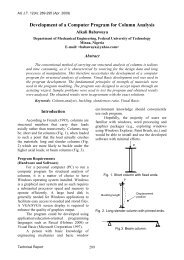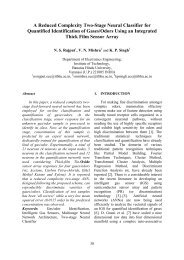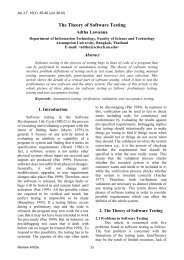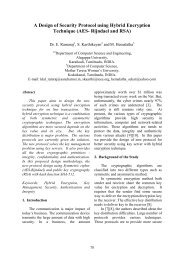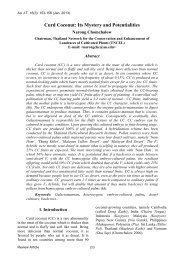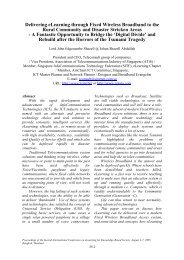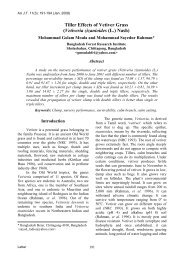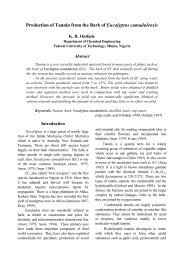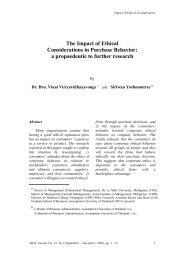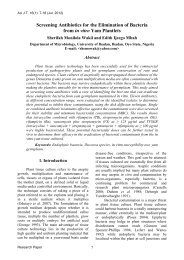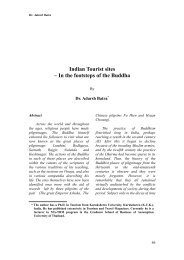Performance Evaluation of a Mixed-Mode Solar Dryer - AU Journal
Performance Evaluation of a Mixed-Mode Solar Dryer - AU Journal
Performance Evaluation of a Mixed-Mode Solar Dryer - AU Journal
You also want an ePaper? Increase the reach of your titles
YUMPU automatically turns print PDFs into web optimized ePapers that Google loves.
<strong>AU</strong> J.T. 11(4): 225-231 (Apr. 2008)<br />
<strong>Performance</strong> <strong>Evaluation</strong> <strong>of</strong> a <strong>Mixed</strong>-<strong>Mode</strong> <strong>Solar</strong> <strong>Dryer</strong><br />
Bukola O. Bolaji and Ayoola P. Olalusi*<br />
Department <strong>of</strong> Mechanical Engineering, University <strong>of</strong> Agriculture<br />
Abeokuta, Ogun State, Nigeria<br />
Email: ayoolalusi@yahoo.co.uk><br />
Abstract<br />
This paper presents the design, construction and performance evaluation <strong>of</strong> a<br />
mixed-mode solar dryer for food preservation. In the dryer, the heated air from a<br />
separate solar collector is passed through a grain bed, and at the same time, the drying<br />
cabinet absorbs solar energy directly through the transparent walls and ro<strong>of</strong>. The<br />
results obtained during the test period revealed that the temperatures inside the dryer<br />
and solar collector were much higher than the ambient temperature during most hours<br />
<strong>of</strong> the day-light. The temperature rise inside the drying cabinet was up to 74% for about<br />
three hours immediately after 12.00h (noon). The drying rate and system efficiency were<br />
0.62 kg/h and 57.5% respectively. The rapid rate <strong>of</strong> drying in the dryer reveals its<br />
ability to dry food items reasonably rapidly to a safe moisture level.<br />
Keywords: solar energy, dryer, mixed-mode, food preservation, performance<br />
evaluation.<br />
Introduction<br />
In many parts <strong>of</strong> the world there is a<br />
growing awareness that renewable energy have<br />
an important role to play in extending<br />
technology to the farmer in developing<br />
countries to increase their productivity<br />
(Waewsak, et al. 2006). <strong>Solar</strong> thermal<br />
technology is a technology that is rapidly<br />
gaining acceptance as an energy saving<br />
measure in agriculture application. It is<br />
preferred to other alternative sources <strong>of</strong> energy<br />
such as wind and shale, because it is abundant,<br />
inexhaustible, and non-polluting (Akinola<br />
1999; Akinola and Fapetu 2006; Akinola, et al.<br />
2006).<br />
<strong>Solar</strong> air heaters are simple devices to<br />
heat air by utilizing solar energy and employed<br />
in many applications requiring low to moderate<br />
temperature below 80 o C, such as crop drying<br />
and space heating (Kurtbas and Turgut 2006).<br />
Drying processes play an important role in the<br />
preservation <strong>of</strong> agricultural products.<br />
They are defined as a process <strong>of</strong> moisture<br />
removal due to simultaneous heat and mass<br />
Technical Report 225<br />
* Affiliated with the Department <strong>of</strong> Agricultural<br />
Engineering, Federal University <strong>of</strong> Technology,<br />
Akure, Nigeria.<br />
transfer (Ertekin and Yaldiz 2004).<br />
According to Ikeji<strong>of</strong>or (1985) two types <strong>of</strong><br />
water are present in food items; the chemically<br />
bound water and the physically held water. In<br />
drying, it is only the physically held water that<br />
is removed. The most important reasons for the<br />
popularity <strong>of</strong> dried products are longer shelflife,<br />
product diversity as well as substantial<br />
volume reduction. This could be expanded<br />
further with improvements in product quality<br />
and process applications.<br />
The application <strong>of</strong> dryers in developing<br />
countries can reduce post harvest losses and<br />
significantly contribute to the availability <strong>of</strong><br />
food in these countries. Estimations <strong>of</strong> these<br />
losses are generally cited to be <strong>of</strong> the order <strong>of</strong><br />
40% but they can, under very adverse<br />
conditions, be nearly as high as 80%. A<br />
significant percentage <strong>of</strong> these losses are<br />
related to improper and/or untimely drying <strong>of</strong><br />
foodstuffs such as cereal grains, pulses, tubers,<br />
meat, fish, etc. (Bassey 1989; Togrul and<br />
Pehlivan 2004)<br />
Traditional drying, which is frequently<br />
done on the ground in the open air, is the most
<strong>AU</strong> J.T. 11(4): 225-231 (Apr. 2008)<br />
widespread method used in developing<br />
countries because it is the simplest and<br />
cheapest method <strong>of</strong> conserving foodstuffs.<br />
Some disadvantages <strong>of</strong> open air drying are:<br />
exposure <strong>of</strong> the foodstuff to rain and dust;<br />
uncontrolled drying; exposure to direct sunlight<br />
which is undesirable for some foodstuffs;<br />
infestation by insects; attack by animals; etc<br />
(Madhlopa, et al. 2002).<br />
In order to improve traditional drying,<br />
solar dryers which have the potential <strong>of</strong><br />
substantially reducing the above-mentioned<br />
disadvantages <strong>of</strong> open air drying, have received<br />
considerable attention over the past 20 years<br />
(Bassey 1989). <strong>Solar</strong> dryers <strong>of</strong> the forced<br />
convection type can be effectively used. They<br />
however need electricity, which unfortunately<br />
is non-existent in many rural areas, to operate<br />
the fans. Even when electricity exists, the<br />
potential users <strong>of</strong> the dryers are unable to pay<br />
for it due to their very low income. Forced<br />
convection dryers are for this reason not going<br />
to be readily applicable on a wide scale in<br />
many developing countries. Natural convection<br />
dryers circulate the drying air without the aid<br />
<strong>of</strong> a fan. They are therefore, the most<br />
applicable to the rural areas in developing<br />
countries.<br />
<strong>Solar</strong> drying may be classified into direct,<br />
indirect and mixed-modes. In direct solar<br />
dryers the air heater contains the grains and<br />
solar energy passes through a transparent cover<br />
and is absorbed by the grains. Essentially, the<br />
heat required for drying is provided by<br />
radiation to the upper layers and subsequent<br />
conduction into the grain bed.<br />
In indirect dryers, solar energy is<br />
collected in a separate solar collector (air<br />
heater) and the heated air then passes through<br />
the grain bed, while in the mixed-mode type <strong>of</strong><br />
dryer, the heated air from a separate solar<br />
collector is passed through a grain bed, and at<br />
the same time, the drying cabinet absorbs solar<br />
energy directly through the transparent walls or<br />
ro<strong>of</strong>. Therefore, the objective <strong>of</strong> this study is to<br />
develop a mixed-mode solar dryer in which the<br />
grains are dried simultaneously by both direct<br />
radiation through the transparent walls and ro<strong>of</strong><br />
<strong>of</strong> the cabinet and by the heated air from the<br />
solar collector. The performance <strong>of</strong> the dryer<br />
was also evaluated.<br />
Technical Report 226<br />
Theory, Materials and Methods<br />
Basic Theory<br />
The energy balance on the absorber is<br />
obtained by equating the total heat gained to<br />
the total heat loosed by the heat absorber <strong>of</strong> the<br />
solar collector. Therefore,<br />
IAc = Qu + Qcond + Qconv + QR + Qρ, (1)<br />
where:<br />
I = rate <strong>of</strong> total radiation incident on the<br />
absorber’s surface (Wm –2 );<br />
Ac = collector area (m 2 );<br />
Qu = rate <strong>of</strong> useful energy collected by the air<br />
(W);<br />
Qcond = rate <strong>of</strong> conduction losses from the<br />
absorber (W);<br />
Qconv = rate <strong>of</strong> convective losses from the<br />
absorber (W);<br />
QR = rate <strong>of</strong> long wave re-radiation from the<br />
absorber (W);<br />
Qρ = rate <strong>of</strong> reflection losses from the absorber<br />
(W).<br />
The three heat loss terms Qcond, Qconv and QR<br />
are usually combined into one-term (QL), i.e.,<br />
QL = Qcond + Qconv + QR. (2)<br />
If τ is the transmittance <strong>of</strong> the top glazing and<br />
IT is the total solar radiation incident on the top<br />
surface, therefore,<br />
IAc = τ ITAc . (3)<br />
The reflected energy from the absorber is given<br />
by the expression:<br />
Qρ = ρτ ITAc, (4)<br />
where ρ is the reflection coefficient <strong>of</strong> the<br />
absorber. Substitution <strong>of</strong> Eqs. (2), (3) and (4) in<br />
Eq. (1) yields:<br />
τ ITAc = Qu + QL + ρτ ITAc, or<br />
Qu = τ ITAc(1 – ρ) – QL.<br />
For an absorber (1 – ρ) = α and hence,<br />
Qu = (ατ)ITAc – QL, (5)<br />
where α is solar absorptance.<br />
QL composed <strong>of</strong> different convection and<br />
radiation parts. It is presented in the following<br />
form (Bansal et al. 1990):<br />
QL = ULAc(Tc – Ta), (6)<br />
where:<br />
UL = overall heat transfer coefficient <strong>of</strong> the<br />
absorber (Wm –2 K –1 );<br />
Tc = temperature <strong>of</strong> the collector’s absorber<br />
(K);
<strong>AU</strong> J.T. 11(4): 225-231 (Apr. 2008)<br />
Ta = ambient air temperature (K).<br />
From Eqs. (5) and (6) the useful energy<br />
gained by the collector is expressed as:<br />
Qu = (ατ)ITAc – ULAc(Tc – Ta). (7)<br />
Therefore, the energy per unit area (qu) <strong>of</strong><br />
the collector is<br />
qu = (ατ)IT – UL(Tc – Ta). (8)<br />
If the heated air leaving the collector is at<br />
collector temperature, the heat gained by the air<br />
Qg is:<br />
Qg = m& a Cpa(Tc<br />
– Ta), (9)<br />
where:<br />
m& = mass <strong>of</strong> air leaving the dryer per unit<br />
a<br />
time (kgs – 1 );<br />
Cpa = specific heat capacity <strong>of</strong> air (kJkg – 1 K – 1 ).<br />
The collector heat removal factor, FR, is<br />
the quantity that relates the actual useful energy<br />
gained <strong>of</strong> a collector, Eq. (7), to the useful<br />
gained by the air, Eq. (9). Therefore,<br />
m&<br />
aC<br />
pa ( Tc<br />
− Ta<br />
)<br />
FR<br />
=<br />
(10)<br />
Ac<br />
[ ατI<br />
T − U L ( Tc<br />
− Ta<br />
)]<br />
or<br />
Qg = AcFR[(ατ)IT – ULAc(Tc – Ta)]. (11)<br />
The thermal efficiency <strong>of</strong> the collector is<br />
defined as (Itodo et al. 2002):<br />
Qg<br />
η c = .<br />
Ac<br />
I T<br />
(12)<br />
Energy Balance Equation for the Drying<br />
Process<br />
The total energy required for drying a<br />
given quantity <strong>of</strong> food items can be estimated<br />
using the basic energy balance equation for the<br />
evaporation <strong>of</strong> water (Youcef-Ali, et al. 2001;<br />
Bolaji 2005):<br />
mwLv = maCp(T1 – T2), (13)<br />
where:<br />
mw = mass <strong>of</strong> water evaporated from the food<br />
item (kg);<br />
ma = mass <strong>of</strong> drying air (kg);<br />
T1 and T2 = initial and final temperatures <strong>of</strong> the<br />
drying air respectively (K);<br />
Cp = Specific heat at constant pressure<br />
(kJkg –1 K –1 ).<br />
The mass <strong>of</strong> water evaporated is calculated<br />
from Eq. 14:<br />
Technical Report 227<br />
m<br />
m<br />
i i<br />
w =<br />
100<br />
where:<br />
( M − M )<br />
− M<br />
e<br />
e<br />
, (14)<br />
mi = initial mass <strong>of</strong> the food item (kg);<br />
Me = equilibrium moisture content (% dry<br />
basis);<br />
Mi = initial moisture content (% dry basis).<br />
During drying, water at the surface <strong>of</strong> the<br />
substance evaporates and water in the inner<br />
part migrates to the surface to get evaporated.<br />
The ease <strong>of</strong> this migration depends on the<br />
porosity <strong>of</strong> the substance and the surface area<br />
available. Other factors that may enhance quick<br />
drying <strong>of</strong> food items are: high temperature,<br />
high wind speed and low relative humidity. In<br />
drying grains for future planting, care must be<br />
taken not to kill the embryo. In drying items<br />
like fish, meat, yam chips, plantain chips etc.,<br />
excessive heating must also be avoided, as it<br />
spoils the texture and quality <strong>of</strong> the item.<br />
Construction <strong>of</strong> the <strong>Mixed</strong>-<strong>Mode</strong> <strong>Solar</strong><br />
<strong>Dryer</strong><br />
The materials used for the construction <strong>of</strong><br />
the mixed-mode solar dryer are cheap and<br />
easily obtainable in the local market. Fig. 1<br />
shows the essential features <strong>of</strong> the dryer,<br />
consisting <strong>of</strong> the solar collector (air heater), the<br />
drying cabinet and drying trays.<br />
Collector (Air Heater): The heat absorber<br />
(inner box) <strong>of</strong> the solar air heater was<br />
constructed using 2 mm thick aluminum plate,<br />
painted black, is mounted in an outer box built<br />
from well-seasoned woods. The space between<br />
the inner box and outer box is filled with foam<br />
material <strong>of</strong> about 40 mm thickness and thermal<br />
conductivity <strong>of</strong> 0.043 Wm –1 K –1 . The solar<br />
collector assembly consists <strong>of</strong> air flow channel<br />
enclosed by transparent cover (glazing). An<br />
absorber mesh screen midway between the<br />
glass cover and the absorber back plate<br />
provides effective air heating because solar<br />
radiation that passes through the transparent<br />
cover is then absorbed by both the mesh and<br />
back-plate. The glazing is a single layer <strong>of</strong> 4<br />
mm thick transparent glass sheet; it has a<br />
surface area <strong>of</strong> 820 mm by 1020 mm and <strong>of</strong><br />
transmittance above 0.7 for wave lengths in the<br />
rage 0.2 – 2.0 μm and opaque to wave lengths
<strong>AU</strong> J.T. 11(4): 225-231 (Apr. 2008)<br />
greater than 4.5 μm. The effective area <strong>of</strong> the<br />
collector glazing is 0.8 m 2 . One end <strong>of</strong> the solar<br />
collector has an air inlet vent <strong>of</strong> area 0.0888<br />
m 2 , which is covered by a galvanized wire<br />
mesh to prevent entrance <strong>of</strong> rodents, the other<br />
end opens to the plenum chamber.<br />
The Drying Cabinet: The drying cabinet<br />
together with the structural frame <strong>of</strong> the dryer<br />
was built from well-seasoned woods which<br />
could withstand termite and atmospheric<br />
attacks. An outlet vent was provided toward the<br />
upper end at the back <strong>of</strong> the cabinet to facilitate<br />
and control the convection flow <strong>of</strong> air through<br />
the dryer. Access door to the drying chamber<br />
was also provided at the back <strong>of</strong> the cabinet.<br />
This consists <strong>of</strong> three removable wooden<br />
panels made <strong>of</strong> 13 mm plywood, which<br />
overlapped each other to prevent air leakages<br />
when closed. The ro<strong>of</strong> and the two opposite<br />
side walls <strong>of</strong> the cabinet are covered with<br />
transparent glass sheets <strong>of</strong> 4 mm thick, which<br />
provided additional heating.<br />
Drying Trays: The drying trays are contained<br />
inside the drying chamber and were<br />
constructed from a double layer <strong>of</strong> fine chicken<br />
wire mesh with a fairly open structure to allow<br />
drying air to pass through the food items.<br />
The orientation <strong>of</strong> the <strong>Solar</strong> Collector: The<br />
flat-plate solar collector is always tilted and<br />
oriented in such a way that it receives<br />
maximum solar radiation during the desired<br />
season <strong>of</strong> used. The best stationary orientation<br />
is due south in the northern hemisphere and<br />
due north in southern hemisphere. Therefore,<br />
solar collector in this work is oriented facing<br />
south and tilted at 17.5 o to the horizontal. This<br />
is approximately 10 o more than the local<br />
geographical latitude (Ado-Ekiti a location in<br />
Nigeria, 7.5 o N), which according to Adegoke<br />
and Bolaji (2000), is the best recommended<br />
orientation for stationary absorber. This<br />
inclination is also to allow easy run <strong>of</strong>f <strong>of</strong> water<br />
and enhance air circulation.<br />
Operation <strong>of</strong> the <strong>Dryer</strong><br />
Fig. 2 shows the isometric drawing <strong>of</strong> the<br />
mixed-mode solar dryer. The dryer is a passive<br />
system in the sense that it has no moving parts.<br />
Technical Report 228<br />
It is energized by the sun’s rays entering<br />
through the collector glazing. The trapping <strong>of</strong><br />
the rays is enhanced by the inside surfaces <strong>of</strong><br />
the collector that were painted black and the<br />
trapped energy heats the air inside the<br />
collector. The green house effect achieved<br />
within the collector drives the air current<br />
through the drying chamber. If the vents are<br />
open, the hot air rises and escapes through the<br />
upper vent in the drying chamber while cooler<br />
air at ambient temperature enters through the<br />
lower vent in the collector. Therefore, an air<br />
current is maintained, as cooler air at a<br />
temperature Ta enters through the lower vents<br />
and hot air at a temperature Te leaves through<br />
the upper vent.<br />
When the dryer contains no items to be<br />
dried, the incoming air at a temperature ‘Ta’<br />
has relative humidity ‘Ha’ and the out-going air<br />
at a temperature ‘Te’, has a relative humidity<br />
‘He’. Because Te > Ta and the dryer contains no<br />
item, Ha > He. Thus there is tendency for the<br />
out-going hot air to pick more moisture within<br />
the dryer as a result <strong>of</strong> the difference between<br />
Ha and He. Therefore, insulation received is<br />
principally used in increasing the affinity <strong>of</strong> the<br />
air in the dryer to pick moisture.<br />
<strong>Dryer</strong> <strong>Performance</strong> <strong>Evaluation</strong><br />
The mixed-mode solar dryer shown in<br />
Fig. 2 was tested in the month <strong>of</strong> September,<br />
2005 to evaluate its performance. During the<br />
testing period, the air temperatures at collector<br />
inlet, collector outlet, plenum chamber, drying<br />
chamber and ambient were measured by<br />
laboratory type mercury bulb thermometers<br />
(accuracy ± 0.5 0 C) at regular interval <strong>of</strong> one<br />
hour between the hours <strong>of</strong> 0.800 and 18.00<br />
local time. The solar intensity was measured by<br />
means <strong>of</strong> a portable Kipps <strong>Solar</strong>imeter placed<br />
at an inclination <strong>of</strong> 17.5 o facing south.<br />
The dryer was loaded with yam chips (4<br />
mm average thickness) and its weight was<br />
measured at the start and at one-hour intervals<br />
thereafter. Knowing the initial weight and the<br />
final weight at the point when no further<br />
weight loss <strong>of</strong> yam chips was attained, the<br />
weight loss was used to calculate the moisture<br />
removed in kg water/kg dry matter at intervals<br />
as the yam dried. The dryer performance was
<strong>AU</strong> J.T. 11(4): 225-231 (Apr. 2008)<br />
evaluated using the drying rate and collector<br />
efficiency. The collector efficiency was<br />
computed using Eq. 12 and the drying rate,<br />
which is the quantity <strong>of</strong> moisture removed from<br />
the food item in a given time, was computed<br />
from Eq. 15 below (Itodo, et al. 2002):<br />
Outlet vent<br />
Transparent ro<strong>of</strong><br />
Drying rack<br />
Drying cabinet<br />
Transparent cover<br />
Absorbers<br />
Inlet vent<br />
200<br />
100<br />
<strong>Solar</strong> collector<br />
dt<br />
⎛ M i − M<br />
=<br />
⎜<br />
⎝ t<br />
dM f<br />
Plenum<br />
chamber<br />
Fig. 1. Sectional view <strong>of</strong> the mixed-mode solar dryer.<br />
1,020<br />
820<br />
700<br />
All dimensions in mm<br />
Fig. 2. Isometric drawing <strong>of</strong> the mixed-mode solar dryer.<br />
Technical Report 229<br />
17.5 0<br />
⎞<br />
⎟ × 100%<br />
. (15)<br />
⎠<br />
540<br />
800<br />
240<br />
366
<strong>AU</strong> J.T. 11(4): 225-231 (Apr. 2008)<br />
Results and Discussion<br />
Fig. 3 shows a typical day results <strong>of</strong> the<br />
hourly variation <strong>of</strong> the temperatures in the solar<br />
collector and the drying cabinet compared to<br />
the ambient temperature. The dryer is hottest<br />
about mid-day when the sun is usually<br />
overhead. The temperatures inside the dryer<br />
and the solar collector were much higher than<br />
the ambient temperature during most hours <strong>of</strong><br />
the daylight. The temperature rise inside drying<br />
cabinet was up to 24 o C (74%) for about three<br />
hours immediately after 12.00h (noon). This<br />
indicates prospect for better performance than<br />
open-air sun drying. Fig. 4 shows the diurnal<br />
variation <strong>of</strong> the relative humidity <strong>of</strong> the<br />
ambient air and drying chamber. Comparison<br />
<strong>of</strong> this figure with Fig. 3 shows that the drying<br />
processes were enhanced by the heated air at<br />
very low humidity.<br />
Fig. 3. A typical day results <strong>of</strong> the diurnal<br />
variation <strong>of</strong> temperatures in the solar dryer.<br />
Fig. 5 shows the drying curve for yam<br />
chips in the mixed-mode solar dryer. It was<br />
observed that the drying rate increased due to<br />
increase in temperature between 10.00h and<br />
14.00h but decreased thereafter, which shows<br />
the earlier and faster removal <strong>of</strong> moisture from<br />
the dried item. The dryer was able to remove<br />
85.4% <strong>of</strong> moisture, dry basis, from 6.2 kg <strong>of</strong><br />
yam chips in one day <strong>of</strong> 10.00h drying time,<br />
which is about 0.62 kg/h drying rate. The<br />
collector efficiency <strong>of</strong> the mixed-mode solar<br />
dryer during the test period was found to be<br />
57.5%.<br />
Technical Report 230<br />
Fig. 4. A typical day results <strong>of</strong> the diurnal<br />
variation <strong>of</strong> relative humidity in the dryer.<br />
Fig. 5. Drying curve for yam chips.<br />
Conclusion<br />
A simple and inexpensive mixed-mode<br />
solar dryer was designed and constructed using<br />
locally sourced materials. The hourly variation<br />
<strong>of</strong> the temperatures inside the cabinet and airheater<br />
are much higher than the ambient<br />
temperature during the most hours <strong>of</strong> the daylight.<br />
The temperature rise inside the drying<br />
cabinet was up to 24 o C (74%) for about three<br />
hours immediately after 12.00h (noon). The<br />
drying rate, collector efficiency and percentage<br />
<strong>of</strong> moisture removed (dry basis) for drying yam<br />
chips were 0.62 kgh –1 , 57.5 and 85.4%,<br />
respectively. The dryer exhibited sufficient<br />
ability to dry food items reasonably rapidly to a<br />
safe moisture level and simultaneously it<br />
ensures a superior quality <strong>of</strong> the dried product.
<strong>AU</strong> J.T. 11(4): 225-231 (Apr. 2008)<br />
However, a lot still has to be done to improve<br />
the performance <strong>of</strong> passive solar dryers. A<br />
possible area <strong>of</strong> improvement is on the use <strong>of</strong><br />
solar storage systems in the dryer to store heat<br />
for use when insulation is insufficient due to<br />
adverse weather conditions and in the night<br />
when insulation is totally absent.<br />
References<br />
Adegoke, C.O.; and Bolaji, B.O. 2000.<br />
<strong>Performance</strong> evaluation <strong>of</strong> solar-operated<br />
thermosyphon hot water system in Akure.<br />
Int. J. Engin. Engin. Technol. 2(1): 35-40.<br />
Akinola, A.O. 1999. Development and<br />
<strong>Performance</strong> <strong>Evaluation</strong> <strong>of</strong> a <strong>Mixed</strong>-<strong>Mode</strong><br />
<strong>Solar</strong> Food <strong>Dryer</strong>. M. Eng. Thesis, Federal<br />
University <strong>of</strong> Technology, Akure, Nigeria.<br />
Akinola, A.O.; and Fapetu, O.P. 2006.<br />
Exergetic Analysis <strong>of</strong> a <strong>Mixed</strong>-<strong>Mode</strong> <strong>Solar</strong><br />
<strong>Dryer</strong>. J. Engin. Appl. Sci. 1: 205-10.<br />
Akinola, O.A.; Akinyemi, A.A.; and Bolaji,<br />
B.O. 2006. <strong>Evaluation</strong> <strong>of</strong> traditional and<br />
solar fish drying systems towards enhancing<br />
fish storage and preservation in Nigeria. J.<br />
Fish. Int., Pakistan 1(3-4): 44-9.<br />
Bassey, M.W. 1989, Development and use <strong>of</strong><br />
solar drying technologies, Nigerian <strong>Journal</strong><br />
<strong>of</strong> <strong>Solar</strong> Energy 89: 133-64.<br />
Bolaji, B.O. 2005. <strong>Performance</strong> evaluation <strong>of</strong> a<br />
simple solar dryer for food preservation.<br />
Proc. 6 th Ann. Engin. Conf. <strong>of</strong> School <strong>of</strong><br />
Engineering and Engineering Technology,<br />
Minna, Nigeria, pp. 8-13.<br />
Ertekin, C.; and Yaldiz, O. 2004. Drying <strong>of</strong><br />
eggplant and selection <strong>of</strong> a suitable thin<br />
Technical Report 231<br />
layer drying model, J. Food Engin. 63: 349-<br />
59.<br />
Ikeji<strong>of</strong>or, I.D. 1985. Passive solar cabinet dryer<br />
for drying agricultural products. In: O. Awe<br />
(Editor), African Union <strong>of</strong> Physics. Proc.<br />
Workshop Phys. Tech. <strong>Solar</strong> Energy<br />
Convers., Univ. <strong>of</strong> Ibadan, Nigeria, pp. 157-<br />
65.<br />
Itodo, I.N.; Obetta, S.E.; and Satimehin, A.A.<br />
2002. <strong>Evaluation</strong> <strong>of</strong> a solar crop dryer for<br />
rural applications in Nigeria. Botswana J.<br />
Technol. 11(2): 58-62.<br />
Kurtbas, I.; and Turgut, E. 2006. Experimental<br />
investigation <strong>of</strong> solar air heater with free<br />
and fixed fins: efficiency and energy loss.<br />
Int. J. Sci. Technol. 1(1): 75-82.<br />
Madhlopa, A.; Jones, S.A.; and Kalenga-Saka,<br />
J.D. 2002. A solar air heater with composite<br />
absorber systems for food dehydration.<br />
Renewable Energy 27: 27–37.<br />
Togrul, I.T.; and Pehlivan, D. 2004. <strong>Mode</strong>lling<br />
<strong>of</strong> thin layer drying kinetics <strong>of</strong> some fruits<br />
under open-air sun drying process. J. Food<br />
Engin. 65: 413-25.<br />
Waewsak, J.; Chindaruksa, S.; and Punlek, C.<br />
2006. A mathematical modeling study <strong>of</strong> hot<br />
air drying for some agricultural products.<br />
Thammasat Int. J. Sci. Technol. 11(1): 14-<br />
20.<br />
Youcef-Ali, S.; Messaoudi, H.; Desmons, J.Y.;<br />
Abene, A.; and Le Ray, M. 2001.<br />
Determination <strong>of</strong> the average coefficient <strong>of</strong><br />
internal moisture transfer during the drying<br />
<strong>of</strong> a thin bed <strong>of</strong> potato slices. J. Food Engin.<br />
48(2): 95-101.



